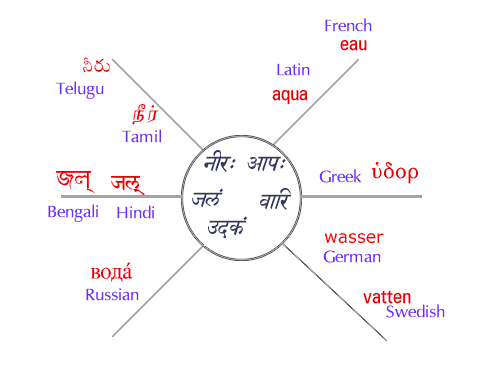Learn Sanskrit through Self Study
Lesson4: Friends in conversation
Section-13: Niruktam ( )
The philosophies of Sanathana Dharma, whether Nyaya or Vaiseshika, whether Sankhya or Yoga or whether Poorva or Uthara Meemamsa, are higly dependent on the Sanskrit Language. The philosophies assume an eternal connection between the Sanskrit word and its meaning. This was mentioned in an earlier lesson in this series where we quoted from the Mahabhashya, the words "siddhe shabdartha sambhandhe"
The philosophies assert that just as creation is a cycle, the Sanskrit words are also created in cycles so that their meanings are essentially eternal. This is the reason why no origin or root for sanskrit can ever be found.
How does the language of Sanskrit utilize this concept in its day to day use? The language is wholly derived from some fundamental root syllables which denote basic concepts like the five elements, movement, energy, space etc.. The five elements are collectively termed as >pancha maha boothaha and individually asprithivi, aapaha, analaha, vaayu, akaashaha
standing for the earth, water, fire, air and the ether respectively. The vedanga which deals with the subject matter of root words occurring in the vedas is termed as Niruktam and is credited (or traced) to the rendition of sage Yaska. Niruktam is divided into three portions in the first of which root words each signifying a simple concept are grouped or classified together. For instance, the words
aapaha, udakam, jalam, neeram, vaari etc.,
all of which denote water, are put under a group along with other words not mentioned above, and the group termed udakanaamaani.
In the second branch of Niruktam, Yaska gives a derivation of these names from their roots. In the third branch of Niruktam, Yaska proceeds to give the meanings of some specific mantras from the Vedas.
It will be obvious to our readers that this feature of the Sanskrit language is wholly unique and is not seen in other languages of the world, whether ancient or modern.
This lends credence to the belief that Sanskrit is the oldest of all the languages of the world.
At the end of this article, we have appended a figure to highlight this aspect of the language in which, we trace the names for water in different languages of the world to their corresponding words in the Sanskrit language.

Next Section Glossary
Previous Section Exercises-9,10
Start of this Lesson
Ravi and Soma
Srinagar
Amarnath
Grammar-1
Grammar-2
Grammar-3
Directions and positions
Indeclinables
Exercises-1,2,3
Exercises-4,5
Exercises-6,7,8
Exercises-9,10
Niruktam
Glossary
Numbers and how to express them
Summary of the lesson
